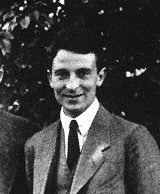Oskar Klein
Oskar Benjamin Klein (born September 15, 1894 in Mörby , Danderyd municipality , † February 5, 1977 in Stockholm ) was a Swedish physicist .
Klein was born in Danderyd, a town north of Stockholm , to the chief rabbi of Stockholm Gottlieb Klein and Antonie Levy. At a young age he became a student and employee of Svante Arrhenius at the Nobel Institute and intended to continue studying with Jean-Baptiste Perrin in France when the First World War broke out and he was drafted into the military. From 1917 on, he worked in Copenhagen with Niels Bohr before taking his disputation at Stockholm University in 1921 . In 1923 he received a call to the University of Michigan , but came back to Copenhagen in 1925 and in 1926 was a lecturer at Lund University . In 1930 he followed Erik Ivar Fredholm as Professor of Physics at Stockholm University.
Together with Theodor Kaluza he developed the Kaluza-Klein theory , an extension of the general relativity theory to include electromagnetism . Together with Hannes Alfvén he developed the Klein-Alfvén cosmology , with Walter Gordon the Klein-Gordon equation of relativistic quantum mechanics , with Yoshio Nishina the Klein-Nishina formula . The Klein paradox denotes compared to the non-relativistic behavior ( Schrödinger equation with potential barrier) paradoxical behavior of solutions of the Dirac equation that describes, for example, electrons in the relativistic quantum mechanics, with potential barriers: these are large enough (of the order of the mass of Diracteilchens) the particles penetrate the barrier almost undisturbed.
In 1959 he was awarded the Max Planck Medal .
Stockholm University and the Nobel Committee will award him the Oskar Klein Medal and lecture in his honor .
Web links
- John J. O'Connor, Edmund F. Robertson : Oskar Klein. In: MacTutor History of Mathematics archive .
Individual evidence
- ↑ Klein: The reflection of electrons at a potential jump according to the relativistic dynamics of Dirac, Zeitschrift für Physik, Volume 53, 1929, p. 157
| personal data | |
|---|---|
| SURNAME | Little, Oskar |
| ALTERNATIVE NAMES | Klein, Oskar Benjamin (full name) |
| BRIEF DESCRIPTION | Swedish physicist |
| DATE OF BIRTH | September 15, 1894 |
| PLACE OF BIRTH | Stockholm |
| DATE OF DEATH | 5th February 1977 |
| Place of death | Stockholm |

